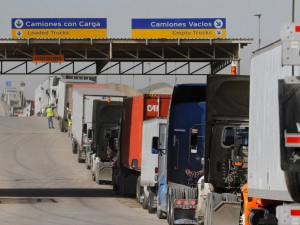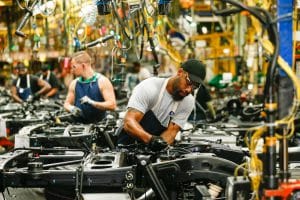
The tariffs on products from Mexico will rise significantly under the USMCA if certain conditions – many of them costly – aren’t met.
The game is about to change for the North American auto industry as the new USMCA trade pact officially goes into effect.
Formally known as the U.S.-Mexico-Canada Agreement, it replaces NAFTA, the three-nation deal that had encouraged the development of an essentially borderless North American automotive production network. How the new agreement will change things is far from clear, though it is expected to result in billions of dollars in higher tariffs while also raising manufacturing costs. Whether it actually will encourage a shift in production back to the U.S., a key goal for the Trump administration, remains one of the unanswered questions.
Automakers and auto parts suppliers did get a minor reprieve in the hours before the USMCA officially took effect on July 1. A senior official with U.S. Customs said the industry will have until the end of this year to certify their compliance with the new rules, and may have as much as a year in which penalties would be waived if they fall short.
(UAW blasts Trump trade deal with China, skeptical about USMCA.)
The new trade law has been dismissed by many as NAFTA 2.0 and, on the whole, it doesn’t stray far from the original North American Free Trade Agreement. But where it does, the impact could pose costly challenges for the auto industry.
Among the key changes:
- To avoid tariffs when coming into the U.S., Mexican-made vehicles like the Jeep Compass will need to contain 75% North American content by value, up from 62.5% under NAFTA;
- How the figure is calculated also changes under USMCA;
- Then there’s the question of wages, 40 to 45% of a vehicle’s content required to come from high-wage sources.
In effect, the latter mandate would either mean shipping some parts production back to the U.S. or Canada or driving up wages in Mexico where third-world levels of pay have been a siren call for the auto industry.
According to research by AlixPartners, the typical worker in a Mexican parts plant earns just $1 to $1.50 an hour, barely a tenth of what comparable wages are in the U.S. The gap is even greater for assembly line workers. Though they typically earn $2.50 an hour in Mexico, their American counterparts generally pull down $70 an hour or more in wages and benefits.
Automakers are already looking for ways to minimize the impact. The new trade pact allows them to factor in the typically much higher wages paid for R&D and engineering employees in Mexico, for one thing. So, if anything, the deal could backfire in some ways, said Mark Wakefield, head of AlixPartners’ automotive practice, warning, “It creates an incentive to put more R&D and engineering into Mexico.”

General Motors shifted 600 jobs from Mexico to its Arlington, Texas plant after the USMCA was signed.
Automakers and suppliers are expected to adjust wages where the labor content on a part is low. Where a part or component requires lots of labor – such as a wiring harness – there may be little to no change in pay.
There have been isolated cases of parts production operations returning to the U.S. from Mexico. In 2017, even before a deal was finalized, General Motors transferred about 600 Mexican jobs to its operations in Arlington, Texas. But it’s far too early to see how much further manufacturers may go. If anything, Mexico actually has increased its share of the parts going into vehicles assembled in the U.S. since USMCA was signed in November 2018. It provided 39.1% of those parts last year, according to government figures, up from 37.4% in 2018.
(U.S. Senate passes NAFTA replacement, sent to Trump for signature.)
What’s clear is that “supply chains don’t change overnight,” cautioned Wakefield. Even if the trade agreement does begin to nudge production back to the U.S., he said, “It will happen over time.” If one thing is certain however, “net costs will go up” for auto assemblers.
Just in terms of added tariffs, automakers can expect to pay an additional $3 billion during the next decade, forecasts the Congressional Budget Office. Higher production could add billions more.
That’s worrisome to industry officials already feeling pushback from consumers about the hefty price hikes they have faced in recent years. The typical new vehicle sold in the U.S. hit an all-time high this spring of around $35,000, according to J.D. Power.

The USMCA could force automakers to shift research and development to Mexico from the U.S. to ensure they meet wage requirements in the deal.
That’s particularly problematic at a time when the U.S. economy is in turmoil as a result of the coronavirus pandemic, said Stephanie Brinley, principal auto analyst with IHS Markit. “A lot of the public is out of work right now, so buying decisions will be under a lot of pressure this year, and probably a least part of the next.”
That worries suburban Detroit retiree Conrad Zumhagen. “Vehicle prices have been going up and that’s discouraging me from buying a new car,” he explained, noting he is now more likely to turn to one of the certified pre-owned programs most manufacturers now offer.
The USMCA is supposed to resolve an assortment of disputes between the three trade partners that, among other things, saw Canadian aluminum and steel products hit with hefty tariffs during the first half of the Trump administration. Its formal implementation has thus received praise from some quarters. Chris Spear, the CEO of the trade group, American Trucking Associations, called it “a tremendous day” that likely will see more cross-border traffic in the coming years.
But not everyone is so upbeat, not with new cracks appearing. Many of them center around the labor reforms Mexico has promised but not yet implemented. Among the critics are Richard Neal, chairman of the House Ways and Means Committee who, on Tuesday, said he “remain(ed) very concerned” about the progress in America’s southern neighbor.
(Trump threatens EU with car tariffs again.)
For their part, autotomakers and suppliers have put on a forced smile and, at the least, they’re happy that they now have formal guidelines in place. But the devil, as the old cliché goes, will be found in the details as they move forward. And, with no clear end to the pandemic – or the recession it has caused – in site – any added costs will be clearly unwelcome.

